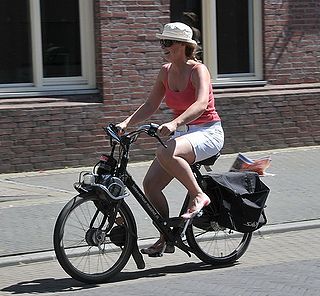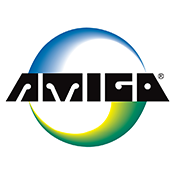
A shopping cart, trolley, or buggy, also known by a variety of other names, is a wheeled cart supplied by a shop or store, especially supermarkets, for use by customers inside the premises for transport of merchandise as they move around the premises, while shopping, prior to heading to the checkout counter, cashiers or tills. Increasing the amount of goods a shopper can collect increases the quantities they are likely to purchase in a single trip, boosting store profitability.

Private transport is the personal or individual use of transportation which are not available for use by the general public, where in theory the user can decide freely on the time and route of transit, using vehicles such as: private car, company car, bicycle, dicycle, self-balancing scooter, motorcycle, scooter, aircraft, boat, snowmobile, carriage, horse, etc., or recreational equipment such as roller skates, inline skates, sailboat, sailplane, skateboard etc.

A motorized bicycle is a bicycle with an attached motor or engine and transmission used either to power the vehicle unassisted, or to assist with pedalling. Since it sometimes retains both pedals and a discrete connected drive for rider-powered propulsion, the motorized bicycle is in technical terms a true bicycle, albeit a power-assisted one. Typically they are incapable of speeds above 52 km/h (32 mph), however in recent years larger motors have been built, allowing bikes to reach speeds of upwards of 72 km/h.

A kick scooter is a human-powered street vehicle with a handlebar, deck, and wheels propelled by a rider pushing off the ground with their leg. Today the most common scooters are made of aluminum, titanium, and steel. Some kick scooters made for younger children have 3 to 4 wheels and are made of plastic and do not fold. High-performance kickbikes are also made.

A mobility scooter is an electric vehicle and mobility aid mostly auxiliary to a power wheelchair but configured like a motorscooter. When motorized they are commonly referred to as a power-operated vehicle/scooter, or electric scooter. Non-motorized mobility scooters are less common, but are intended for the estimated 60% of wheelchair users who have at least some use of their legs. Whilst leg issues are commonly assumed to be the reason for using scooters, the vehicles are used by those with a wide range of conditions from spinal to neurological.

A motorized scooter is a stand-up scooter powered by either a small internal combustion engine or electric hub motor in its front and/or rear wheel. Classified as a form of micro-mobility, they are generally designed with a large center deck on which the rider stands. The first motorized scooter was manufactured by Autoped in 1915.

Hoveround is an American corporation that manufactures and distributes the Hoveround brand of power wheelchairs and sells scooters, lifts, ramps and power chair accessories.

A mobility aid is a device designed to assist walking or otherwise improve the mobility of people with a mobility impairment.

A scooter is a motorcycle with an underbone or step-through frame, a seat, and a platform for the rider's feet, emphasizing comfort and fuel economy. Elements of scooter design were present in some of the earliest motorcycles, and motor scooters have been made since at least 1914.

A motorized shopping cart is a shopping cart equipped with an electric motor and navigational controls. It includes a seat thereby also making it a motorized wheelchair, and it has a rechargeable battery that can be charged by plugging in the device when not in use in order to maximize usage. Motorized shopping carts are provided by supermarkets and other large retail stores for those with permanent or temporary physical disabilities who may have difficulty walking through a large store or pushing a regular cart.

A motorized wheelchair, powerchair, electric wheelchair or electric-powered wheelchair (EPW) is a wheelchair that is propelled by means of an electric motor rather than manual power. Motorized wheelchairs are useful for those unable to propel a manual wheelchair or who may need to use a wheelchair for distances or over terrain which would be fatiguing in a manual wheelchair. They may also be used not just by people with 'traditional' mobility impairments, but also by people with cardiovascular and fatigue-based conditions.

Ralph William Braun was the founder and CEO of the Braun Corporation. He is also known as the "Father of the Mobility Movement" at BraunAbility.

Invalid carriages were usually single seater road vehicles, buggies, or self-propelled vehicles for disabled people. They pre-dated modern electric mobility scooters and, from the 1920s, were generally powered by small gasoline/petrol engines, although some were battery powered. They were usually designed without foot-operated controls.
BraunAbility is an American manufacturer of wheelchair accessible vans and wheelchair lifts based in Winamac, Indiana. It is currently owned by Investor AB. The company was founded by Ralph Braun, who had spinal muscular atrophy. Braun designed a wheelchair lift and steering controls, which allowed him to drive a 1970 converted full size Dodge van. He began converting vans to sell to others. As sales grew, Braun was able to acquire Independent Mobility Systems. IMS had previously been the largest manufacturer of wheelchair minivans. Braun also acquired the Viewpoint Mobility line of wheelchair minivans, United Access, Performance Mobility, Kersey Mobility, ADA and Wheel Chair Vans of Florida. Company sales have grown to $950 million a year in 2022.

A personal transporter is any of a class of compact, mostly recent, motorised micromobility vehicle for transporting an individual at speeds that do not normally exceed 25 km/h (16 mph). They include electric skateboards, kick scooters, self-balancing unicycles and Segways, as well as gasoline-fueled motorised scooters or skateboards, typically using two-stroke engines of less than 49 cc (3.0 cu in) displacement. Many newer versions use recent advances in vehicle battery and motor-control technologies. They are growing in popularity, and legislators are in the process of determining how these devices should be classified, regulated and accommodated during a period of rapid innovation.

A scooter-sharing system is a shared transport service in which electric motorized scooters are made available to use for short-term rentals. E-scooters are typically "dockless", meaning that they do not have a fixed home location and are dropped off and picked up from certain locations in the service area.

Micromobility refers to a range of small, lightweight vehicles operating at speeds typically below 25 km/h (15 mph) and driven by users personally. Micromobility devices include bicycles, e-bikes, electric scooters, electric skateboards, shared bicycle fleets, and electric pedal assisted (pedelec) bicycles.
Ola Electric Mobility is an Indian electric two-wheeler manufacturer, based in Bengaluru, Karnataka, India. It is India's largest electric two-wheeler manufacturer valued around US$6 billion as of May 2023. It has a manufacturing facility located in Krishnagiri, Tamil Nadu which is India's largest two-wheeler EV manufacturing factory.
















